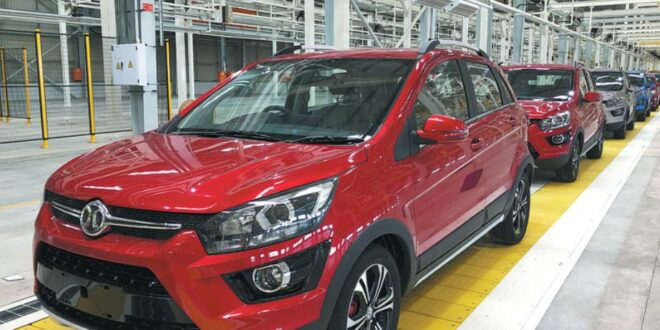After wrapping up the political section of his recent working trip to China, Uzbekistan’s President Shavkat Mirziyoyev took the long way home from Beijing by passing through the southern city of Shenzen.
He traveled there to visit the headquarters of leading Chinese automaker BYD, which has just overtaken Elon Musk’s Tesla as the world’s best-seller of electric vehicles.
And then, together with BYD chief executive Wang Chuanfu, he oversaw a remote launch ceremony for an assembly plant of hybrid and electric cars to be built in Uzbekistan’s Jizzakh region. Once completed, the factory will turn out 50,000 units per year.
As far as Mirziyoyev is concerned, this is just the start. The range of models slated for production in the Jizzakh region plant needs be expanded “in the near future” to accommodate market demand and annual production capacity should be increased to 300,000 units, he said.
The groundwork on making the production facility a reality has been years in the laying. BYD and Uzbek government-controlled car company UzAuto signed an initial agreement in August 2022 on developing the plant as a joint venture later dubbed BYD Uzbekistan Factory. That took a firmer shape in October 2023, when the parties signed an investment agreement.
The plan for now is for the factory to make BYD Song Plus DM-i and BYD Chaser 05 hybrid models (the latter model is marketed as BYD Chazor in Uzbekistan). Significantly, as a BYD press release from October notes, the Jizzakh factory will handle the entire production cycle, from welding and painting to assembly.
“The agreement also provides the joint venture the right to export BYD vehicles that are manufactured in Uzbekistan to Central Asian countries,” the statement read.
Russia may be another destination for Uzbek-made BYDs in the fullness of time.
When he was at the Shenzen HQ, Mirziyoyev was ceremonially handed the keys to a YangWang U8, a BYD luxury SUV that retails at around $150,000. It may have been that model he had in mind when he spoke about diversifying production.
While that price tag is out of range for most Uzbek buyers, demand is red-hot in Russia. BYD announced it would begin selling YangWang U8s in Russia in September. By the first week of October, it had racked up pre-orders for 4,000 units. By the end of that same month, the number was more than 30,000.
BYD is only the latest Chinese automaker to set up shop in Uzbekistan. Uzbek vehicle distribution company Roodell began assembling cars for Wuhu-based Chery Automobile in September 2022, also at a plant in Jizzakh.
When those cars began retailing the following month, Chery offered customers preferential loans so they might be able to manage prices ranging from $26,000 for their Tiggo 7 Pro model to $40,000 for the Tiggo 8 Pro Max.
A healthy number of Chery models are ending up on Kazakhstan’s market too.
According to the most recent data released by the Association of Kazakhstan Automobile Business, Chery has become the country’s fourth most-popular vehicle brand. In the first seven months of 2023, car dealers sold almost 7,000 Chery cars, a 269 percent increase on the same period a year earlier.
Already sensing that sales were only scratching the surface, auto dealer Astana Motors in November 2022 got to work on a plant that will eventually produce models by Chery and other Chinese automakers, Changan and Haval. The plant was reported at the time to have a design capacity to produce more than 90,000 units per year and was slated to start operating in the fourth quarter of 2024.
It isn’t just small vehicles that Chinese companies are making in Central Asia.
A joint venture between China’s Yutong and Kazakh company QazTehna in September 2021 began producing buses of various dimensions, including electric models, at a manufacturing facility in the town of Saran, near Karaganda. Production capacity at the time of the launch was said to stand at around 1,200 buses per year.
“Our products are designed for the markets of Kazakhstan and the Eurasian Economic Union,” QazTehna general director Argulan Maykonov said at the opening, referring to the Russia-dominated trading bloc.
With cities across Central Asia trying to turn their urban transport systems green, Yutong is in a prime position to profit.
Uzbekistan’s Ecology Ministry announced earlier this month that Samarkand is poised to buy 100 electric buses from Yutong as part of a major upgrade of the city’s public transport system. Money to install the required infrastructure is coming in part from the European Bank for Reconstruction and Development.
It has not been spelled out, however, if the specific vehicles in question are coming from the Kazakhstan plant.
Central Asia has now also notoriously become a conduit for the export of Chinese vehicles in less formal ways too.
Russian car market analytics company Avtostat revealed in December that Kyrgyzstan had since the start of 2023 exported 60,000 cars to Russia. With 80 percent of new cars in Russia arriving from China, it is not difficult to make the connection.
This bonanza for Kyrgyz re-exporters has been made possible by Russia’s withering economic ties with the West.
But there are indications this window may be closing. When Russia began its invasion of Ukraine, it loosened the rules by which consumers and traders could import and then register cars bought from abroad. With the relaxed rules set to expire in coming weeks, Kyrgyzstan’s re-export model may be adversely affected.
But Chinese automakers that have sold their products – likely unwittingly – via Kyrgyzstan, meanwhile, will have a fallback in the form of their partners in Kazakhstan and Uzbekistan.

 Iran Energy News Oil, Gas, Petrochemical and Energy Field Specialized Channel
Iran Energy News Oil, Gas, Petrochemical and Energy Field Specialized Channel



